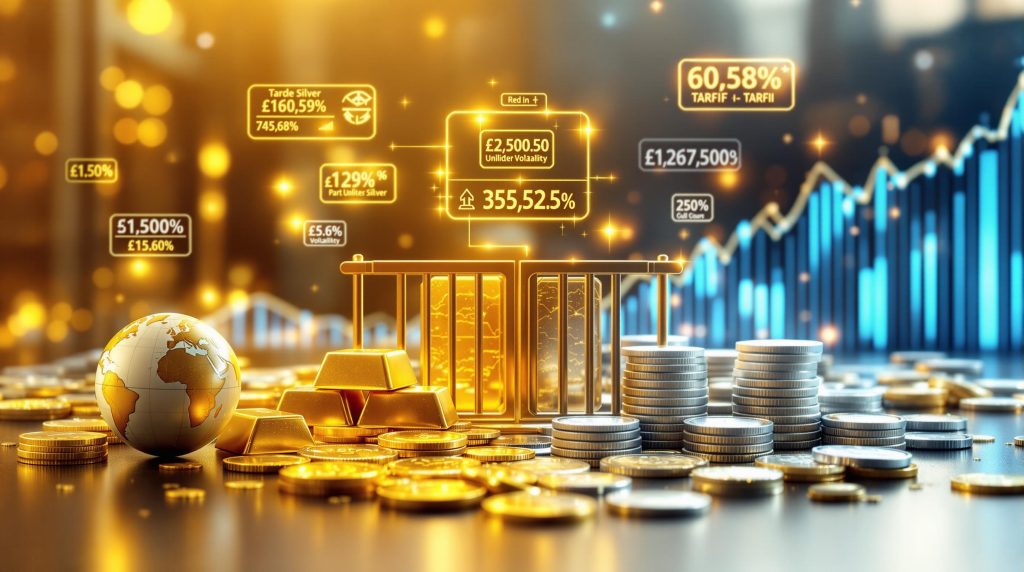Understanding Gold and Silver Tariffs: Market Implications and Investment Considerations
What Are Precious Metal Tariffs and How Do They Work?
Definition and Implementation Mechanics
- Import taxes specifically targeting gold, silver, and other precious metals
- Can be structured as percentage-based fees (ad valorem) or fixed amounts per ounce/gram
- Implementation varies by country, metal type, and current trade policies
- Creates artificial price differentials between international markets
- May apply differently to various forms (bullion, jewelry, industrial components)
Tariffs on gold and silver represent governmental attempts to control the flow of these monetary metals across borders. When implemented, they fundamentally alter the economics of precious metals trading, creating ripple effects throughout the market ecosystem.
Recent Tariff Developments and Controversies
- Conflicting announcements creating market uncertainty
- Rapid policy reversals causing price volatility
- Concerns about potential implementation on monetary metals
- Pre-emptive market reactions including accelerated imports
- Differing treatment between industrial and investment-grade metals
Historical precedent shows that government intervention in precious metals markets often precedes significant monetary system changes. The 1933 Executive Order 6102, which prohibited private gold ownership in the United States, demonstrates how dramatically policy can impact metals markets.
How Do Tariffs Impact Precious Metal Market Dynamics?
Trading Liquidity and Price Discovery Effects
- Reduces arbitrage opportunities between major trading hubs
- Disrupts the critical London-New York spread that facilitates liquidity
- Widens bid-ask spreads as market makers adjust for increased risk
- Creates artificial price differentials between international markets
- Complicates price discovery mechanisms for global participants
When tariffs on gold and silver are implemented, they immediately fragment what should be a global market. Arbitrage traders who normally ensure price consistency across exchanges find their business model compromised by the additional costs, leading to less efficient markets overall.
Market Volatility Consequences
- Single-day price swings exceeding $100 following tariff announcements
- Rapid succession of new highs followed by sharp corrections
- Increased hedging activity to manage unpredictable price movements
- Amplified reaction to news and policy statements
- Trading patterns becoming less predictable and more sentiment-driven
Volatility tends to increase during periods of policy uncertainty, as market participants attempt to position themselves ahead of implementation dates. This creates temporary distortions that can present both risks and opportunities for informed investors.
Supply Chain and Inventory Adjustments
- Accelerated imports ahead of potential implementation dates
- Strategic repositioning of metal inventories across jurisdictions
- Changes in storage patterns without physical withdrawal
- Altered delivery and settlement preferences
- Regional premium differences reflecting tariff impact on investments
Physical metals tend to flow toward jurisdictions with the most favorable regulatory environment. This can create temporary shortages in some regions while others experience inventory buildups, affecting local premiums and availability.
Who Stands to Gain or Lose From Precious Metal Tariffs?
Potential Beneficiaries in a Tariffed Environment
- Domestic mining operations gaining competitive advantages
- Existing physical metal holders seeing potential appreciation
- Storage facilities in non-tariffed jurisdictions experiencing increased demand
- Traders capitalizing on market dislocations and arbitrage opportunities
- Domestic refiners processing locally-sourced materials
Mining companies operating within countries imposing tariffs often see their competitive position improve as imported metal becomes more expensive. This can translate to improved profit margins and potentially accelerated development of domestic resources.
Parties Facing Negative Consequences
- Metal importers confronting higher acquisition costs
- Manufacturing sectors using precious metals as production inputs
- International bullion banks with cross-border operations
- Retail investors experiencing higher premiums and reduced selection
- Market makers facing increased hedging costs and operational complexity
Industries that rely on precious metals as production inputs face difficult choices when tariffs are imposed: absorb the higher costs and reduce margins, pass costs to consumers, or seek alternative materials. Each option presents its own set of challenges and competitive implications.
What's Driving the Current Precious Metals Market Consolidation?
Technical Market Patterns and Trading Ranges
- Four-month consolidation period following strong initial 2023-2024 gains
- Similar duration to previous consolidation phases since 2020
- Building technical support at higher price levels
- Reduced volatility within defined trading ranges
- Healthy market digestion following rapid price appreciation
Market consolidations typically represent periods where early buyers who purchased at lower prices take profits while new participants establish positions. This transfer of ownership often creates trading ranges that persist until a new catalyst emerges.
Fundamental Factors Supporting Current Price Levels
- Growing sovereign debt concerns, particularly U.S. $37+ trillion national debt
- Anticipated monetary policy shifts including potential QE resumption
- Changing institutional attitudes toward precious metals allocation
- Global currency devaluation concerns as debt monetization continues
- Geopolitical tensions creating safe-haven demand
The fundamental case for gold and silver has strengthened as global debt levels have reached unprecedented heights. With many major economies facing debt-to-GDP ratios exceeding 100%, the historical role of precious metals as monetary alternatives has regained prominence.
Why Are We Seeing Record Gold Delivery Requests?
Analysis of COMEX Physical Delivery Trends
- Unprecedented standing for physical gold delivery in recent months
- Metals remaining within vault systems rather than being withdrawn
- Shift from paper to physical ownership without geographical movement
- Changing risk assessment among major market participants
- Preference for allocated rather than unallocated positions
The increase in delivery requests without corresponding vault withdrawals suggests a shift in ownership preference rather than physical metal shortages. Market participants increasingly prefer direct ownership claims rather than derivative exposure.
Who Might Be Behind Increased Physical Delivery Demands?
- High-net-worth individuals seeking wealth preservation
- Major financial institutions hedging against monetary uncertainty
- Investment funds adjusting portfolio allocations
- Wealth managers responding to client concerns about financial system stability
- Forward-thinking investors anticipating monetary policy consequences
Institutional interest in precious metals has grown significantly as traditional portfolio models face challenges in the current economic environment. The 60/40 stock/bond allocation has underperformed during recent inflationary periods, prompting reassessment of alternative assets.
Motivations for Physical Ownership Preference
- Concerns about counterparty risk in paper gold instruments
- Desire for direct ownership without intermediaries
- Protection against potential settlement disruptions
- Eliminating third-party claims on assets
- Insurance against financial system instability
The 2008 financial crisis demonstrated how quickly counterparty risk can materialize in seemingly stable markets. This lesson has not been forgotten by sophisticated investors who recognize the value of assets without counterparty risk.
Would Major Investor Participation Significantly Impact Silver Prices?
Market Impact Analysis of Institutional Buying
- Short-term price spikes followed by profit-taking and normalization
- Limited long-term price impact from single-entity purchases
- Historical precedent from 1990s institutional silver purchases
- Temporary momentum creation without fundamental market structure change
- Global monetary conditions outweighing influence of even large individual investors
The silver market has historically demonstrated that even large buyers have limited long-term price impact unless fundamentals support sustained higher prices. Warren Buffett's Berkshire Hathaway purchased approximately 130 million ounces in the late 1990s, creating only a temporary price increase.
Trader vs. Long-Term Holder Dynamics
- Majority of market participants trading for profit rather than accumulation
- Speculative positions dominating daily price action
- Long-term holders representing minority of market volume
- Different time horizons creating selling into strength by existing holders
- Fundamental supply-demand factors ultimately determining sustained price trends
The silver market contains diverse participants with different objectives and time horizons. Price movements often reflect this diversity, with traders responding to short-term technical signals while long-term holders focus on fundamental monetary and industrial factors.
How Might Current Economic Conditions Affect Precious Metals Markets?
Economic Warning Signals and Implications
- Multiple international conflicts creating market uncertainty
- Housing market pressures emerging in major economies
- Unsustainable sovereign debt trajectories requiring intervention
- Banking system stresses potentially necessitating liquidity injections
- Currency devaluation risks as debt monetization continues
Historical analysis shows precious metals typically perform well during periods of financial stress and currency debasement. The current economic landscape features several warning signs that have preceded previous metals bull markets.
Monetary Policy Considerations
- Central bank intervention becoming increasingly necessary
- Potential for new quantitative easing programs within months
- Historical correlation between monetary expansion and precious metal prices
- Currency competition and debasement concerns
- Precious metals serving as monetary alternatives during financial stress
Central banks face difficult policy choices as economic growth slows while debt levels remain elevated. Historical precedent suggests that precious metals often benefit from the monetary expansion that typically follows economic contraction.
What Investment Strategies Make Sense in the Current Environment?
Physical Ownership Considerations
- Benefits and limitations of direct metal ownership
- Storage options across jurisdictions to mitigate policy risk
- Premium assessment and acquisition timing strategies
- Liquidity planning for various market scenarios
- Authentication and quality assurance importance
Physical ownership provides advantages in terms of eliminating counterparty risk, but presents challenges regarding storage, insurance, and liquidity. Investors must carefully consider these trade-offs when determining appropriate allocation strategies.
Portfolio Allocation Approaches
- Balancing gold and silver exposure based on risk tolerance
- Complementary asset classes for comprehensive protection
- Position building strategies during consolidation phases
- Considering mining equities versus physical metals
- Liquidity reserves for volatility opportunities
Diversification across precious metals types and ownership structures can provide more comprehensive protection against various economic scenarios. Gold traditionally offers stability while silver provides greater upside potential during bull markets, as indicated by gold-silver ratio insights.
How Would a Monetary System Reset Affect Precious Metals?
Potential Scenarios for Systemic Financial Change
- Debt restructuring implications for currency values
- Historical precedent from previous monetary system transitions
- Purchasing power preservation during currency devaluations
- Potential for precious metals reintegration into monetary frameworks
- Transition period considerations for investors
Throughout history, monetary systems have undergone periodic resets when debt levels become unsustainable. The transition from the Bretton Woods system to the current fiat currency regime in 1971 marked the last major reset, resulting in significant gold market price surge.
Preparation Strategies for Financial Instability
- Diversification across asset classes and jurisdictions
- Physical possession versus professional storage trade-offs
- Communication and information source reliability during crises
- Community resilience and local exchange considerations
- Maintaining optionality through various ownership structures
Financial system transitions create both risks and opportunities. Historical examples suggest that preparation before instability becomes obvious provides significant advantages during periods of monetary restructuring.
FAQs About Gold and Silver Tariffs
Would tariffs help or hurt precious metal prices long-term?
Tariffs primarily create short-term volatility rather than changing long-term price drivers. While reduced market liquidity could amplify price movements, fundamental factors like monetary policy, debt levels, and global economic conditions remain the primary determinants of sustained price trends. Recent gold high price analysis shows this market complexity.
How might tariffs affect premiums on physical precious metals?
Retail premiums would likely increase as dealers factor in higher acquisition costs, supply chain disruptions, and market uncertainty. The spread between spot prices and retail prices could widen significantly, particularly for imported products directly affected by tariff implementation.
Could domestic mining operations benefit from precious metal tariffs?
Domestic producers would gain competitive advantages as imported metals become more expensive. This could improve profit margins for mining companies operating within non-tariffed jurisdictions and potentially accelerate domestic exploration and development projects.
What steps can investors take to prepare for potential tariff implementation?
Diversify storage locations across jurisdictions, maintain cash reserves for volatility opportunities, consider owning both physical and investment vehicles, and stay informed about policy developments through reliable sources like The Guardian's reporting on gold prices.
How would tariffs affect international precious metal trading relationships?
Trade flows would likely redirect to minimize tariff impacts, potentially creating new regional hubs and altering traditional market relationships. Countries without tariffs could become more prominent in international precious metals trade, while tariffed nations might see reduced market influence, according to recent CNBC analysis on gold futures.
Further Exploration:
Readers interested in learning more about gold and silver market dynamics can also explore related educational content on YouTube, such as interviews with precious metals analysts discussing market trends and economic factors affecting these important monetary metals. The gold price forecast 2025 provides additional context for long-term investors.
Want to Get Ahead of the Next Major Mineral Discovery?
Stay informed on significant mineral discoveries with real-time alerts from Discovery Alert, powered by the proprietary Discovery IQ model that turns complex data into actionable insights. Explore why major discoveries can lead to substantial returns by visiting Discovery Alert's dedicated discoveries page and position yourself ahead of the market.




